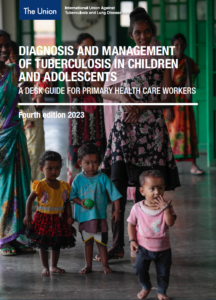
This Desk Guide focuses on the Asia region. The Africa region guide is available here.
This desk Guide provides management Guidelines that are consistent with the World Health Organization’s Consolidated Guidelines for child and adolescent tuberculosis published in 2022 and The Union’s Management of Tuberculosis: A Guide to Essential Practice published in 2019. This desk Guide is a decision-aid intended for use by primary health care workers and does not cover all possible situations and/or solutions related to the management of childhood TB.
The clinical judgment of the health worker remains the basis for final decision-making, and this aid is not a substitute for clinical expertise and individual assessment. It aims to provide guidance for the more common and straightforward cases presenting for care in resource-limited settings.
Introduction
Tuberculosis (TB) is an important cause of illness and death in children and adolescents, especially in high TB incidence countries.
Around one and a half million children and adolescents become ill with TB every year, and nearly 250,000 children die from this curable and preventable disease.
Many TB cases in children and adolescents are not detected, especially in young children (<5 years), who account for most deaths in children due to TB.
Based on careful clinical assessment, the diagnosis of TB can be made in most children and adolescents in an outpatient setting.
Contact history is an important part of the assessment for diagnosis and prevention.
Every child and adolescent with presumptive or confirmed TB should be tested for HIV infection.
Children and adolescents with TB respond well to treatment.
All children with TB should be routinely registered with and reported to the national tuberculosis programme (NTP) of the country in question.
The desk Guide is primarily intended for:
- Health workers who manage sick children and adolescents in primary-level health facilities or outpatient settings at any level of care, especially in high TB burden settings; and
- NTP staff who manage children and adolescents as part of NTP work.
The desk Guide aims to improve:
- Early and accurate case detection and diagnosis;
- Timeliness of management and treatment outcomes; and
- Appropriate child contact screening and management.
The desk Guide will focus on:
- How to diagnose common forms of TB in children and adolescents;
- To treat children and adolescents with TB;
- When to refer children with TB; and
- How to manage close contacts of people with TB.